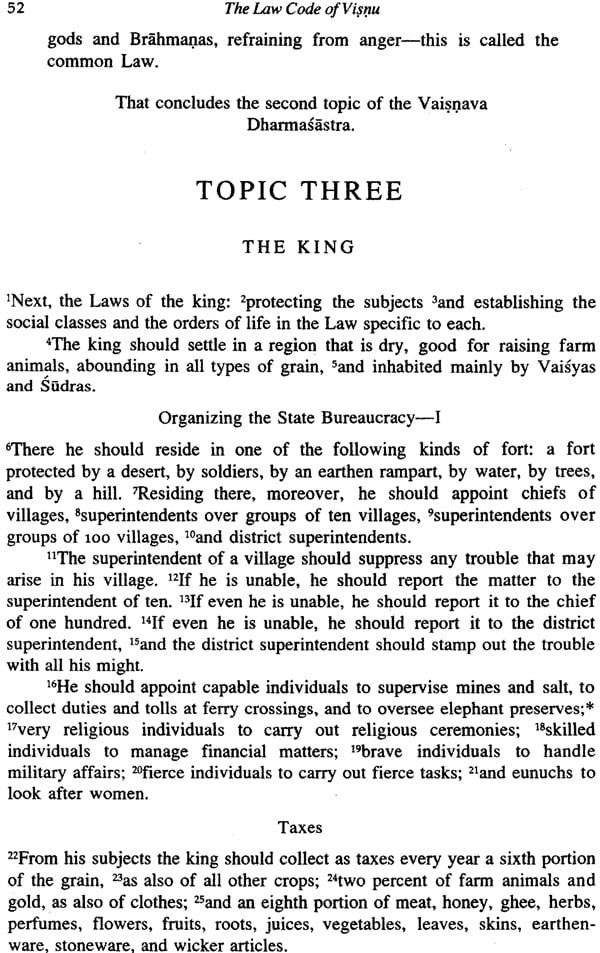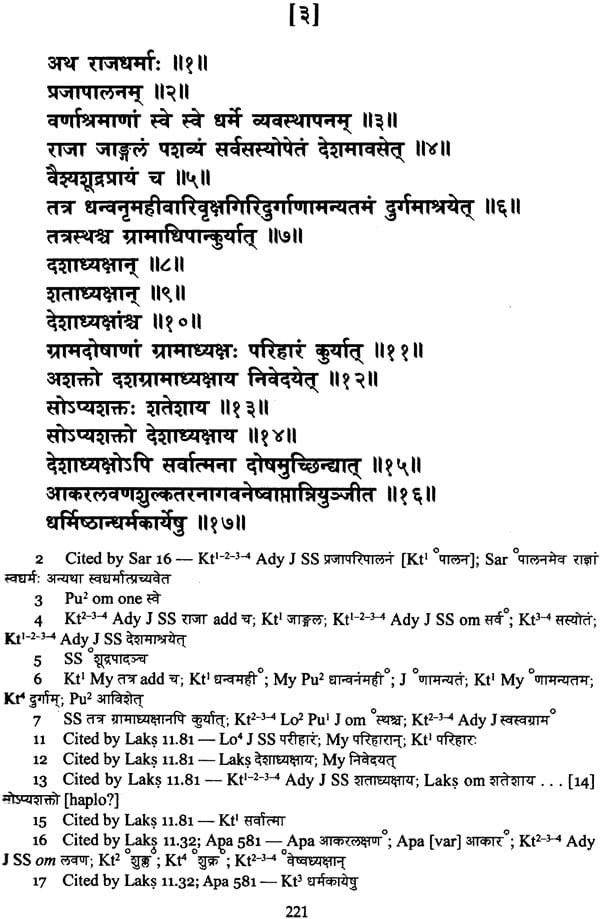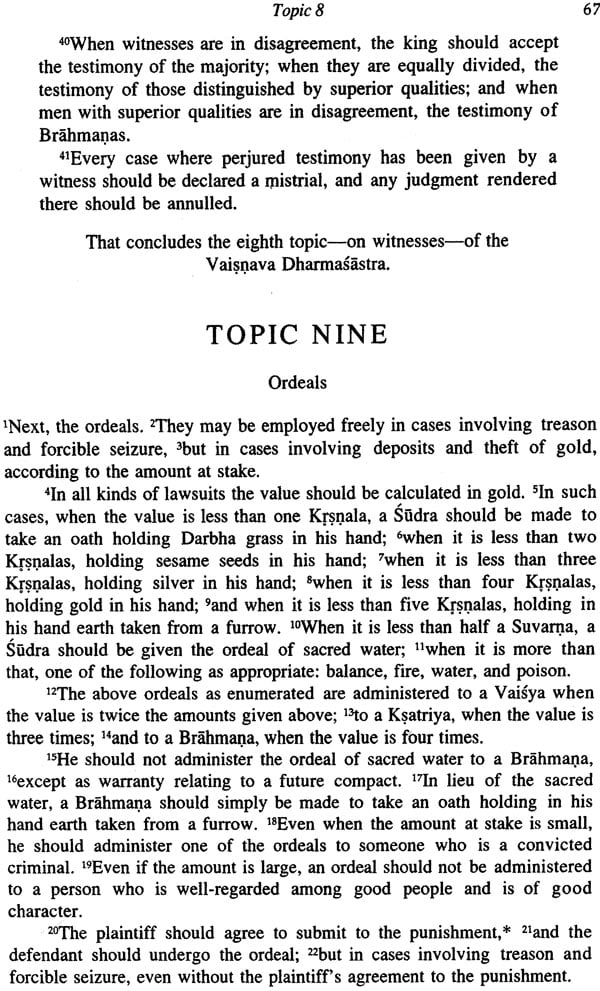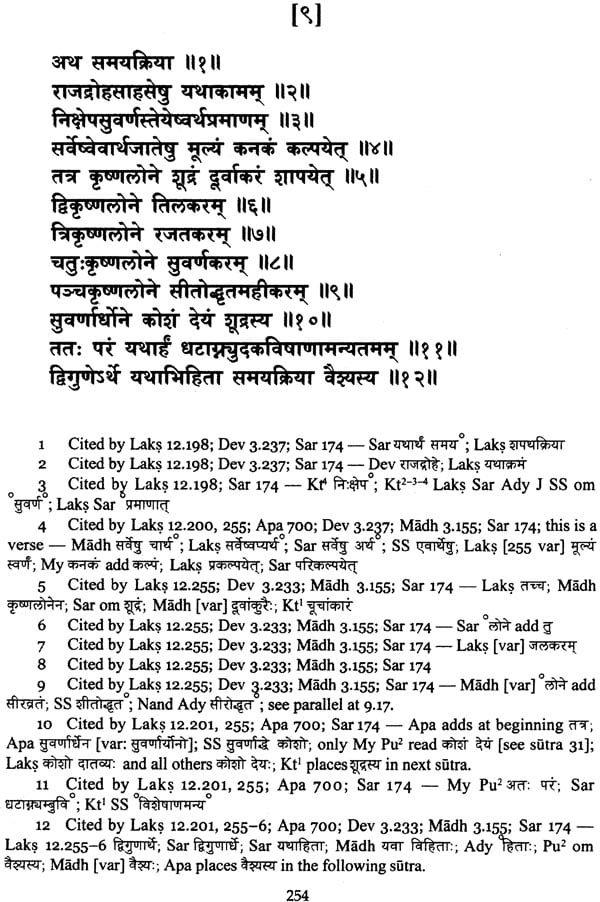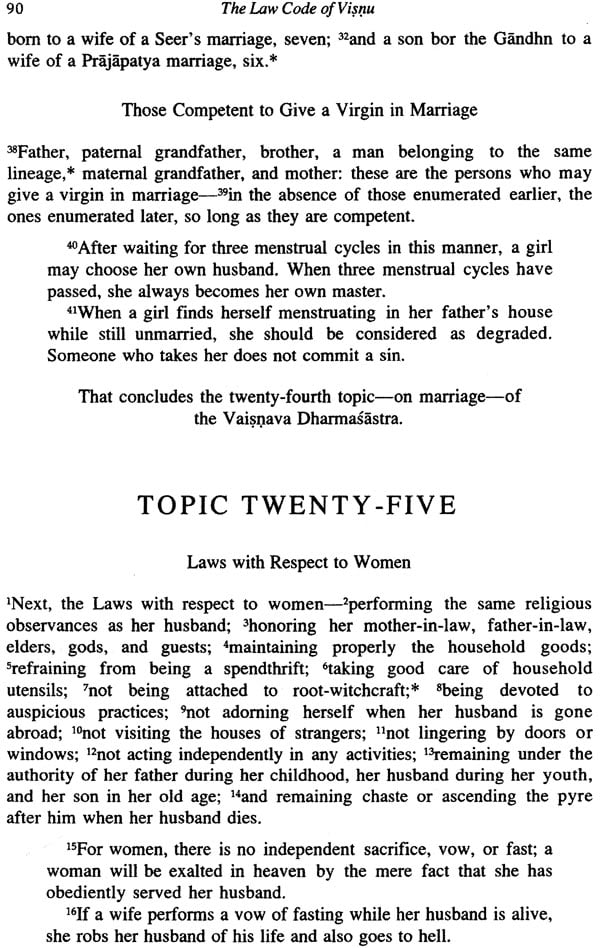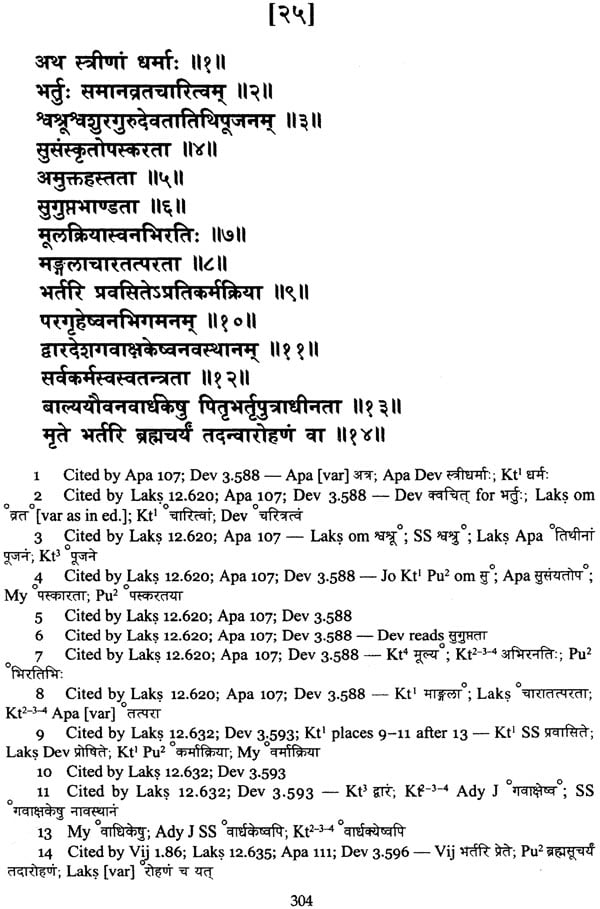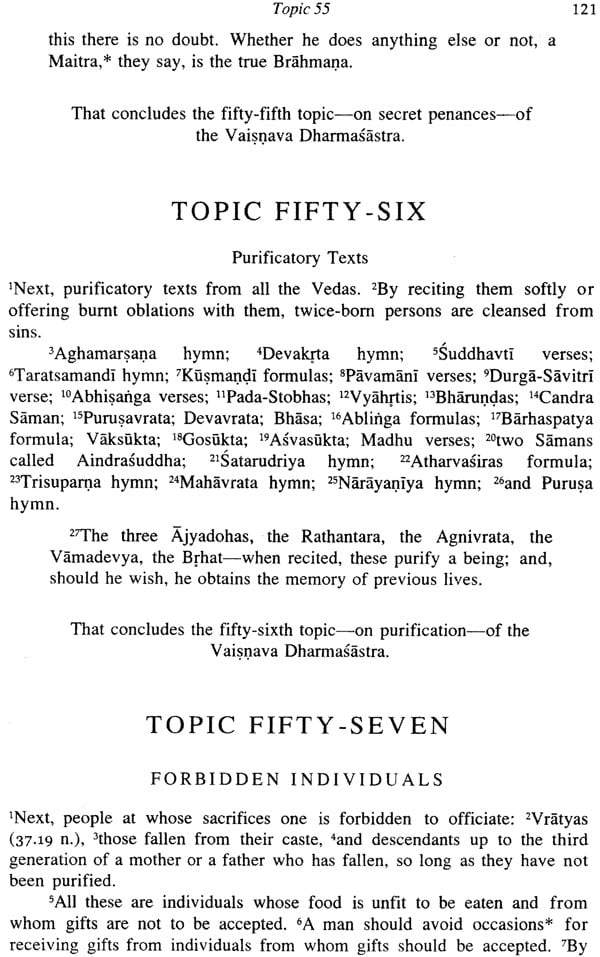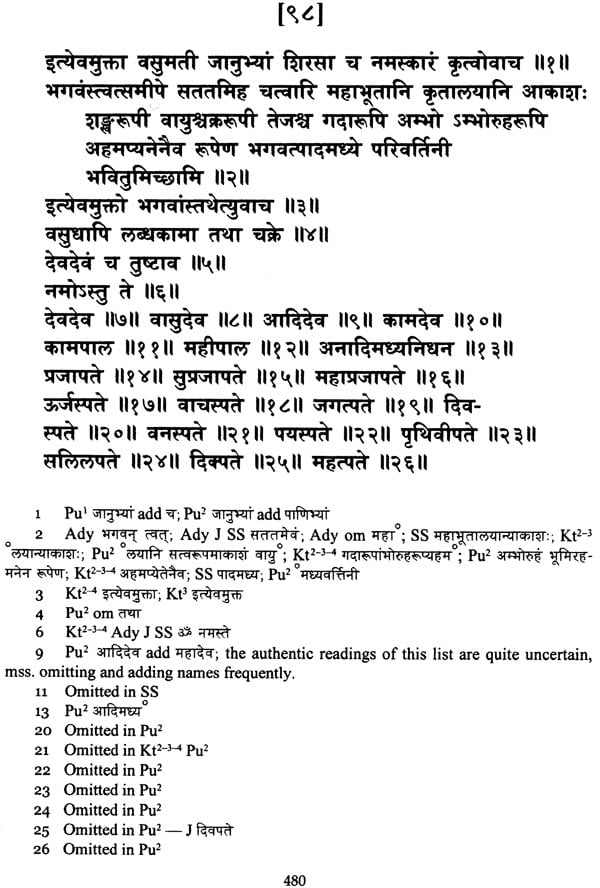
The Law Code of Visnu (A Critical Edition and Annotated Translation of The Vaisnava-Dharmasastra)
Book Specification
| Item Code: | NAO695 |
| Author: | Patrick Olivelle |
| Publisher: | Primus Books, Delhi |
| Language: | Sanskrit Text With English Translation |
| Edition: | 2018 |
| ISBN: | 9789386552877 |
| Pages: | 608 (8 B/W Illustrations) |
| Cover: | Hardcover |
| Other Details | 10.0 inch X 7.5 inch |
| Weight | 1 kg |
Book Description
In this first critical edition of the legal treatise of Visnu Smrti), Olivelle locates the text geographically in Kashmir and dates it to around the seventh century a based, among other factors, on the iconographic description of Visnu. The text was composed by a scholar who belonged to the Kathaka branch of the Yajur Veda and who was also an adherent of the Vaisnava Pancaratra tradition. This is the only legal text that shows a deep influence of the bhakti tradition. Although the Visnu Smrti did not have as illustrious a life as the treatises of Manu and Yajfiavalkya, we find it cited frequently in medieval legal digests. Indeed, unlike citations from other Dharm8astras, medieval authors regularly cite entire sections of this treatise, indicating that they were familiar with a text more or less identical to the one that has come down to us. Consisting of 100 chapters, the text is framed as a conversation between goddess Earth and Visnu, with Earth requesting the dharma that should govern the lives of those belonging to the four varnas. Originally published in the Harvard Oriental Series, this Indian edition will hopefully make this important text available to a wider Indian audience of scholars and students.
Composed in the seventh century CE, The Law Code of Vishnu owes its uniqueness among other things to its localization in Kashmir, its historical linkage with the Vedic Kathaka branch, a unitary, Pancaratra affiliated authorship, and, in a departure from Dharm8astric conventions, to its innovativeness in terms of legal subjects and arrangement. This book is an invaluable primary source for scholars with research interests in Kashmir and in comparative ancient Indian law. It presents its readers with what is appreciated unanimously as the tried and trusted hallmark of Olivellean publications: exhaustive introduction, critically established text, annotated scholarly translation and comprehensive indexes. Professor Lavelle’s The Law Code of Visnu stands out as another pinnacle of his scholarship in the field of ancient Indian jurisprudence.
Patrick Olivelle is Professor Emeritus of Sanskrit in the Department of Asian Studies at the University of Texas at Austin, and past President of the American Oriental Society. Author of over 30 books and 50 articles, Olivelle's books have won awards from the American Academy of Religion and the Association of Asian Studies. His major publications include: Yjnavalkya: A Treatise on Dharma (2018); Dharma Reader: Classical Indian Law (2016); A Sanskrit Dictionary of Law and Statecraft (2015); King, Governance, and Law in Ancient India (2013); Life of the Buddha (2008); Manu's Code of Law (2005); and Upanisads (1996).
The Vaisnava Dharmasastra, more commonly known as Visnu Smrti, is not as well known or as ancient as other Dharmasastras, such as those of Manu and Yajnavalka. Nevertheless, it represents a significant moment in the history of the Dharmasastric literature in ancient India. It is also the only text of this tradition that can be geographically localized. I began work on this text around four years ago, as my work on the critical edition of the Manava Dharmasastra was coming to an end. I am delighted to present to the scholarly public the first critical edition, with an accompanying annotated translation, of this text.
There are many individuals and institutions that helped me during the years when I was preparing this edition and translation. The National Archives of Nepal generously provided copies of manuscripts, as did the Bhandarkar Oriental Research Institute in Pune, and the Oriental Manuscripts Library of the University of Mysore. The Adyar Library and Research Centre generously gave me permission to use its edition of the Visnu Smrti with the commentary of Nandapandita. My colleague Joel Brereton was generous with his time and knowledge in resolving some difficult textual problems.
My wife, Suman, read the entire work several times and caught numerous errors and lapses. She and my student David Brick collated most of the manuscripts used in this edition. I want to thank in a special way Professor Michael Wetzel for agreeing to include this volume in the Harvard Oriental Series.
Among the extant Dharmasastras,1 the Vaisnava Dharmasastra (Vida), commonly known as Vim-sin/it, is the forgotten step child. It is not much in evidence in the modern scholarship on ancient Indian jurisprudence; it was also by and large ignored by the native scholarship, at least as far as commentators are concerned.2 Only in 1679 was a commentary on it finally written by the Benares pandit Nandapandita, although according to the very late Sarasvativilasa (16th century CE) there appears to have been a commentary on this text by Bharuci; it provides numerous quotations from this commentary.3 The extensive citations from the ViDh in medieval legal digests (nibandha), such as Laksmidhara's Krtyakalpataru and commentaries, such as Aparaditya's Apararka on the Yajnavalkya Dharmasastra, however, show that it was widely read by medieval Dharmasastric scholars.
In what follows, I will challenge this version of the textual history of the ViDh and argue for its unitary authorship and present the reasons for assigning it a rather later date. We can draw a few conclusions with some degree of certainty regarding three points: 1. The ViDh belongs to the ritual tradition of the Kathaka branch of the Veda; 2. It was composed in Kashmir; and 3. Although there may have been some redactoral activities, the text by and large was the work of a single author who was a devotee of Visnu, perhaps belonging to the Pancaratra tradition .4 There is simply no evidence that an ancient Kathaka Dharmasatra, irrespective of whether it ever existed, formed the core of the ViDh. Regarding its date, there is less certainty; but we should not be too far off in assigning it to a period roughly between the seventh and eighth centuries CE.
I. 1 The Kathaka Connection
Jolly (1880, xi-xiii) demonstrated over a century ago the close connection between the ViDh and the texts of the Kathaka branch, especially the Kathaka Grhyasastra. We see close parallels between the two texts in sections 21, 67, 73, 74, and 86. Not only does the ViDh give mantras traceable only in the Kdtgr, many of the sutras themselves are taken directly from the Grhya text.
5 The term rama is used with the specialized and peculiar meaning of a crow only in the ViDh (73.26) and the Katgr (63.19). We also find the reference to the first pancaka, the second pancaka, and so on in connection with mantras to be used in a sraddha ceremony (ViDh 73.5-8); these groups of five mantras are also referred to in the Kiitgr (67-69).
4. Obviously I have revised my own views on this matter expressed a few years ago in my critical edition of the Mdh, where I wrote with regard to the imitation of Manu by later writers: "Visnu is the only exception, but this text was a recast of an original sutra composition; indeed, the entire first topic, which is clearly the work of the redactor, is in verse" (Olivelle 2005, 67). 5. For example, the description of the rites in section 67 parallels Igniter 54; ViDh 73.5-8 parallels Katgr 67-69.
There are also mantras cited in the ViDh that are found only in the Kathaka Samhita. Furthermore, when the ViDh cites well-known Vedic mantras, it frequently cites the versions found in the Kathaka Samhita rather than those from other Vedic Sarphitas.6 Even as late a commentator as Nandapandita knew the connection between the ViDh and the Kathaka branch. He frequently notes that a particular mantra cited in the ViDh is from the Kathaka.
Even though there is unmistakable evidence of close parallels between the ViDh and the Kathaka branch in general and the laitGr in particular, I cannot follow Baler and Jolly in their conclusion that "the bulk of the so-called Vishnu-smriti is really the ancient Dharma-sutra of the Karayaniya-kathaka Sasha of the Black Yagur-veda. It ranks, like the other Dharma-sutras, with the Grihya and Srauta-sutras of the its school" (Jolly 1881, xii). As I will demonstrate below, the ViDh is a much later work unconnected to the Kalpa Sutras of the Kathaka branch. If it were the Dharmasutra of the Kathakas, it is inexplicable that as fine a commentator as Devapala in his commentary on the Kdtgr does not mention or quote from the ViDh, while he cites other Dharmasastras. Parallels with the Katter can easily be explained if the author of the ViDh was a well-educated Brahmin of the Kathaka branch; he would have been inclined to cite Kathaka versions of mantras with which he was familiar and to reproduce the ritual descriptions from the Katgr.
There are, however, a few references to and citations from a Kathaka, which may refer to either a lost Kathaka Sm.rti or an earlier version of the current ViDh bearing that name. First, the Nyayamanjari of Jay anta Bhatt (circa 890 CE), a Kashmiri text, mentions kathakasmrti in a list of five smrtis.9 It is unclear whether the reference is to a lost text or to the ViDh under a different name. A thus-far unknown commentary on the Ydh, a long fragment of which is located in the National Archives of Nepal, 10 cites three passages referring them to lcdthake. On YDh 1.81 the citation reads: tatha ca kathaka I apina svo vijinasyamanah patibhih saha sayiran (similar to TS 2.5.1.5; see Vadh 5.8). This may well be a reference to a lost passage in the KS parallel to the TS, as we have references to maitrayaniye in this commentary at YDh 1.89, where we also have three references to kathaka with passages sounding like Dharma-Sastra or Grhyasastra: punardarakriyam kuryad yadi bharya nasty; savagnayo bhavanty ete ye patnyam mrtayam dharyante; nairrtyam catuspathe nikhanet. All three passages refer to the death of a wife. Given the difficult textual transmission of all the texts of the Kathakas, it is difficult to assume that these references are drawn from a lost Kathaka Dharmasutra, although it cannot be ruled out.
I. 2 The Kashmiri Connection
Jolly (1881, xv) on the basis of its Kathaka connection posited Kashmir as the home of the ViDh, because of the fact that "adherents of the Karayaniya-kathaka school survive nowhere but in Kashmir." This is clearly a strong argument, especially if we date the ViDh to the middle of the first millennium CE, during which time the Kathakas were confined to the north-western region of the subcontinent. Further, there are unmistakable connections between the ViDh and the Visnu Dharmottara Purana, another text from Kashmir belonging roughtly to the same period as the ViDh.11 In the critical apparatus to the critical edition, I have drawn attention to the parallels between the two texts. The title of the Vidhpu and some comments within the text may indicate that it presupposed a text on dharma connected to Visnu. Inden (2000, 43-45) boldly identifies this text as the ViDh. This connection, however, is not as clear or as certain as Inden makes it out to be. The most we can say is that there are close connections between the two texts; it is not altogether clear whether one text presupposes the other or both have drawn from a common source.
There are, moreover, compelling iconographic grounds for locating the ViDh in Kashmir. The frame story of the ViDh takes us back to the time when the night of Brahma, the end of a Kalpa, was over, and Visnu, wishing to create the universe, realized that Earth, Prthvi, was submerged in water. In his Varaha-avatara, Visnu plunged into the ocean and lifted up Earth. Earth, however, was tro ubled by the thought of who would support her in the future. She goes first to Kasyapa and, at his urging, goes to the milk ocean to see Visnu himself.
Contents
| Preface | v | |
| Abbreviations | ix | |
| Introduction | 3 | |
| Authorship and Composition | 4 | |
| The Kathaka Connection | 5 | |
| The Kashmiri Connection | 7 | |
| The Vaisnava Connection | 12 | |
| Author and Date | 13 | |
| Structure and Content | 15 | |
| The Frame Story | 16 | |
| The Structure and Style | 18 | |
| Borrowings | 22 | |
| Innovations | 26 | |
| Life of the Text | 28 | |
| Taranslation | 39 | |
| Editor's Outline | 41 | |
| Notes to the Translation | 167 | |
| Critical Edition | 197 | |
| Introduction to the Critical Edition | 199 | |
| Appendices | 493 | |
| I. | Fauna and Flora | 495 |
| II. | Names of Gods, People, and Places | 496 |
| III. | Ritual Vocabulary | 505 |
| IV. | Weights, Measures, and Currency | 512 |
| Bibliography | 513 | |
| Dharmasastric Parallels | 519 | |
| Sutra Index | 533 | |
| Index to the Translation | 575 |
Sample Pages
